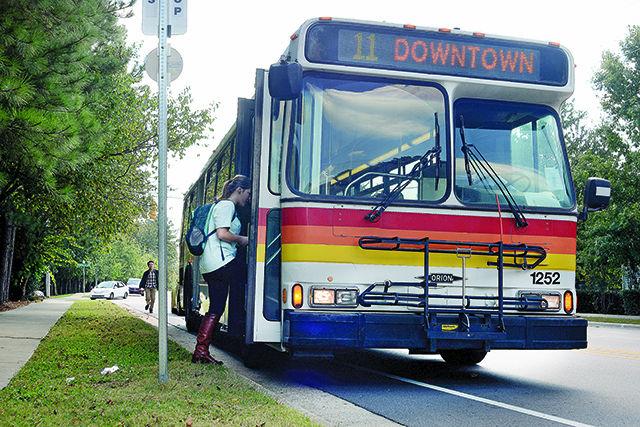 " />
" />
Caide Wooten
Cameron Millet, sophomore in accounting, boards the No. 11 Avent Ferry CAT bus Tuesday afternoon, Oct. 21, 2014, on Trailwood Dr. Triangle area public buses, including the Capital Area Transit (CAT), Triangle Transit Authority (TTA), and Durham Area Transit Authority (DATA) will all soon be operating under the "Go" brand. Now buses will have similar paint jobs and be operating with similar names like Go Raleigh and Go Durham. All NC State students will still be able to ride for free on the buses with GoPasses, which can be acquired from the university transportation office.
Triangle system transportation is currently going through a rebranding process that involves uniting the five main providers of public transportation in the Triangle area under one name, “Go.” Raleigh city council has most recently approved of this change, and soon the Capital Area Transit will be changed to GO Raleigh.
Currently two of the five transit systems, Chapel Hill Transit and Cary’s C-Tran, are awaiting further meetings to continue with this rebranding. Triangle Transit and Durham Area Transit have already accepted this movement, and will become GO Triangle and GO Durham.
Many students around NC State rely heavily on the bus system for transportation. All students are eligible for a GoPass which allows them access to any of the five buses running in the Triangle area.
“I use the bus to get to events downtown,” said Tyler Murphy, a freshman in engineering. “It is so much easier than walking or finding parking.”
This is not the first time the different transportation systems in the Triangle area have joined forces.
“The various transit providers in the Triangle have a long history of working together. After having success with these other areas, we then decided to turn our attention to how we market to our customers,” said Damien Graham, Triangle Transit’s director of communications and public affairs. “Our goal from the outset was to find a new name and design scheme that would allow for local flavor and identity but would demonstrate regional connection. We believe the ‘Go’ concept achieves this goal.”
Although the rebranding of the transit systems means that there will be a mutual name and design scheme shared, each system will remain separately under the jurisdiction of their area.
“By adding a common design scheme and name change to the area bus systems we are hoping to demonstrate to our customers that even though we have multiple transit systems in operation, they do connect and coordinate with one another,” Graham said.
The rebranding process will be a gradual change to coordinate. Once the final details are set, Triangle Transit systems plan to have press events in order to educate the public on the new designs and system. There will also be publicity on social media sites.
This process will take several months to complete with new paint for the buses and uniforms for employees.
“Generally as we move forward with this, a lot of rebranding takes place, sometimes with different entities overnight, and this is not one of these cases. We will be phasing in new paint schemes, websites, logos, uniforms and things in that nature, so it’s going to take some time,” said David Eatman, transit administrator for Triangle Transit. “All of our communication resources are at least done and changed over to the new brand so we want the general public to be aware that there are smaller, gradual changes going through.”
The city of Raleigh is also cycling in new buses and using the older ones as well. During the transition, there may be a combination of the old designed buses and the newly designed buses running all at once.
“As new uniforms, signs, brochures and other collateral materials need to be produced, they will have the new design scheme on them,” Graham said. “Once all the old buses have cycled out, the new name and design concept will be quite powerful. In a perfect world, we would love to have one great reveal and have every bus, uniform, sign, brochure, etc. have the new name and design on it. Unfortunately, we don’t have the fiscal resources available to execute the transition in that matter, so we need to make this transition in the most economical way possible.”
Currently, there are also a few buses running around Raleigh that have not yet received a painted design.
“I saw a plain white bus and I wasn’t sure what it was,” said Keion Henry, a freshman in management. “I did not take it because I was too confused on where it would particularly go.”
Ideally, the department of transportation at Triangle Transit would want the customers to know that although the transit systems may be run by different sectors, they are very closely coordinated.
“We [the transit providers] feel it is important to keep challenging ourselves to come up with new and innovative ways to connect with our customers and improve their overall experience with transit,” Graham said.